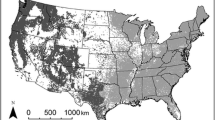Summary
The problems of allocating new vegetation stands to an existing classification are outlined. As one solution, the vegetation samples from an area may be ordinated by reciprocal averaging and classified by dividing the ordination into community-types. The ordination scores for a short list of species present in a new sample may then be averaged to locate that sample on the ordination axes and in one of the community-types. The method is tested by comparing estimates from incomplete species lists with that from a complete list of species in an forest stand in southern Ghana.
Résumé
Le problème d'insérer des relevés nouveaux dans une classification préexistante est esquissé. Une solution est de soumettre les relevés de la région étudiée à une analyse factorielle des correspondances, obtenant ainsi une ordination divisible en types de végétation. Un relevé nouveau peut se poser sur les axes de l'ordination, et dans le type correct, si la valeur moyenne d'ordination est calculée pour une liste brève des espèces constituantes.
Similar content being viewed by others
References
Ashton, P.S. 1964. Ecological studies in the mixed dipterocarp forests of Brunei State. Oxf. For. Mem. 25: 1–75.
Austin, M.P., P.S. Ashton & P. Greig-Smith. 1972. The application of quantitative methods to vegetation survey. III. A re-examination of rain forest data from Brunei. J. Ecol. 60: 305–324.
Curtis, J.T. & R.P. McIntosh. 1951. An upland forest continuum in the prairie-forest border region of Wisconsin. Ecology 32: 476–496.
Goff, F.G. & P.H. Zedler. 1972. Derivation of species succession vectors. Amer. Midl. Natur. 87: 397–412.
Greig-Smith, P. 1969. Analysis of vegetation data: the user viewpoint. International Symposium on Statistical Ecology, New Haven 3: 149–162.
Greig-Smith, P., M.P. Austin & T.C. Whitmore. 1967. The application of quantitative methods to vegetation survey. I. Association analysis and principal components analysis ordination of rain forest. J. Ecol. 55: 483–503.
Hall, J.B. & M.D. Swaine. In press. Classification and ecology of closed-canopy tropical forest in Ghana. J. Ecol.
Hatheway, W.H. 1969. Contingency-table analysis of rain forest vegetation. International Symposium on Statistical Biology, New Haven 3: 271–314.
Hill, M.O. 1973. Reciprocal averaging: an eigenvector method of ordination. J. Ecol. 61: 237–249.
Hill, M.O., R.G.H. Bunce & M.W. Shaw. 1975. Indicator species analysis: a divisive polythetic method of classification, and its application to a survey of native pinewoods in Scotland. J. Ecol. 63: 597–613.
Hutchinson, J. & J.M. Dalziel. 1954–1972. Flora of West Tropical Africa. 2nd edition revised by R.W.J. Keay and F.N. Hepper. Crown Agents, London, 3 vols.
Lambert, J.M., S.E. Meacock, J. Barrs & P.F.M. Smartt. 1973. Axor and Monit: two new polythetic divisive strategies for hierarchical classification. Taxon 22: 173–176.
Noy-Meir, I: 1973. Divisive polythetic classification of vegetation data by optimized division on ordination components. J. Ecol. 61: 753–760.
Poore, M.E.D. 1955. The use of phytosociological methods in ecological investigations. I. The Braun-Blanquet system. J. Ecol. 43: 226–244.
Sneath, P.H.A. & R.R. Sokal. 1973. Numerical Taxonomy. W.H Freeman & Co., San Francisco, 573 pp.
Swaine, M.D. 1973. Some aspects of vegetation change. Ph. D. thesis, University of Wales.
Webb, L.J., J.G. Tracey, W.T. Williams & G.N. Lance. 1970. Studies in the analysis of complex rain-forest communities. V. A comparison of the properties of floristic and physiognomic-structural data. J. Ecol. 58: 202–232.
Williams, W.T. & J.M. Lambert. 1959. Multivariate methods in plant ecology. I. Association-analysis in plant communities. J. Ecol. 47: 83–101.
Williams, W.T., G.N. Lance, L.J. Webb & J.G. Tracey. 1973. Studies in the analysis of complex rain-forest communities. VI. Models for the classification of quantitative data. J. Ecol. 61: 47–70.
Author information
Authors and Affiliations
Additional information
Nomenclature follows Hutchinson & Dalziel (1954–72) except where authorities are given.
We gratefully acknowledge the assistance of Mr. M.O. Hill in the correct formulation of the ‘coordinate estimation’ procedure.
Rights and permissions
About this article
Cite this article
Swaine, M.D., Hall, J.B. An application of ordination to the identification of forest types. Plant Ecol 32, 83–86 (1976). https://doi.org/10.1007/BF02111902
Accepted:
Issue Date:
DOI: https://doi.org/10.1007/BF02111902




